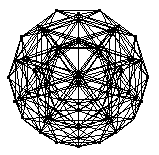
The 600-cell is the finite regular four-dimensional polytope with Schläfli symbol . It is also known as the hypericosahedron or hexacosichoron.
It is composed of 600 tetrahedra, with 5 to an edge.
The 600-cell has 120 vertices (Coxeter 1969) and 720 edges. It is one of the six
regular polychora.
In the plate following p. 160, Coxeter (1973) gives two illustrations of the polytope.
The dual of the 600-cell is the 120-cell.
The vertices of the 600-cell with circumradius 2 and edge length , where
is the golden ratio, are
given by the following sets (Coxeter 1969, pp. 403-404).
1. The 96 even permutations of .
2. The 8 permutations of .
3. The 16 permutations of .
There are 8 distinct nonzero distances between vertices of the 600-cell in 4-space.
The skeleton of the 600-cell, shown above in several projections, is a 12-regular graph of girth 3 and diameter 5. The numbers of vertices at graph distance , 1, 2, ... from a given vertex on the skeleton of the 600-cell
are 1, 12, 32, 42, 32, and 1 (OEIS A118785).
The graph spectrum of the 600-cell is
(Buekenhout and Parker 1998). The skeleton of the 600-cell is implemented in the
Wolfram Language as GraphData["SixHundredCellGraph"].
The 600-cell has
distinct nets (Buekenhout and Parker 1998). The order of its automorphism group is (Buekenhout and Parker 1998).
The independence number of the 600-cell skeleton is 24 (Debroni et al. 2010) and its chromatic number is 5 (R. Pratt, pers. comm., Dec. 2, 2011).